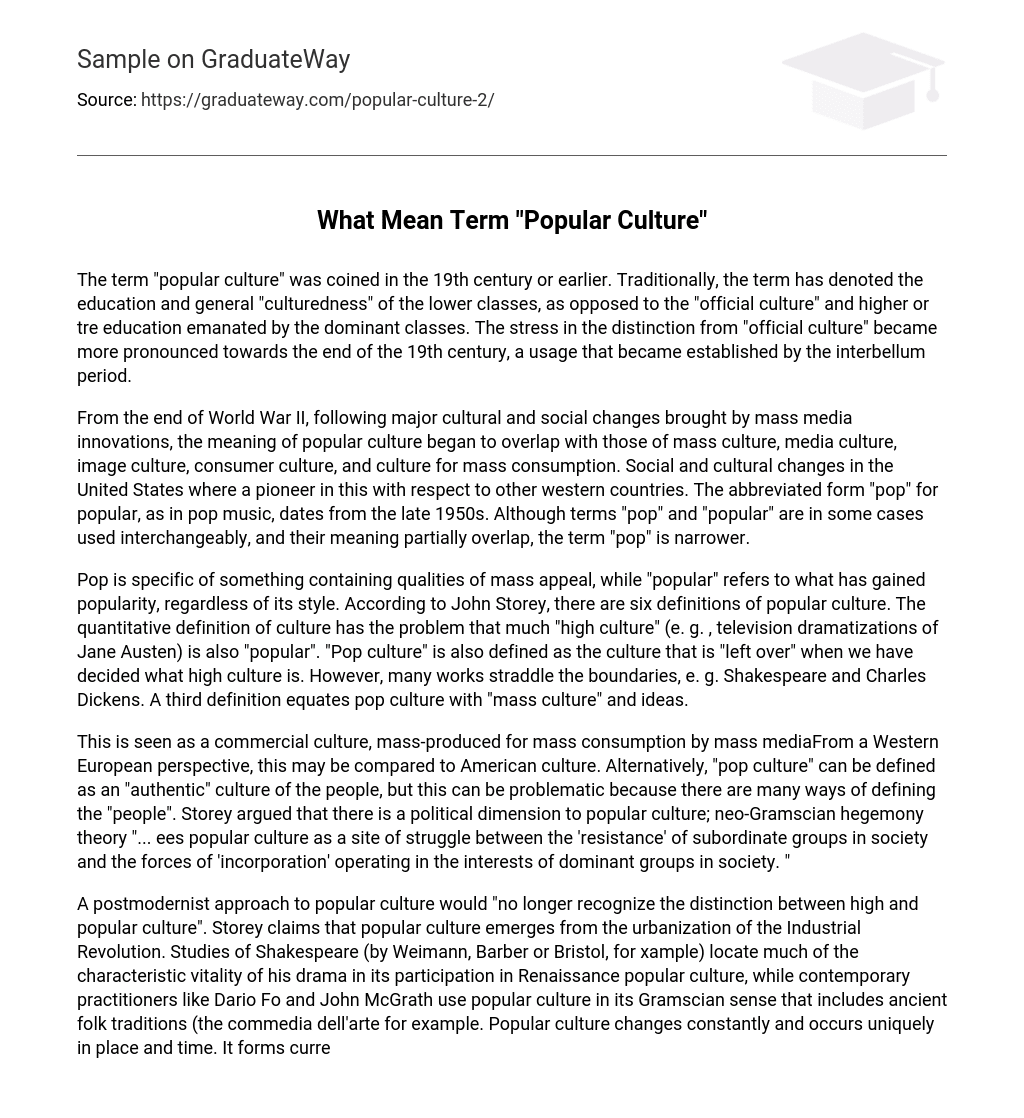The term “popular culture” was coined in the 19th century or earlier. Traditionally, the term has denoted the education and general “culturedness” of the lower classes, as opposed to the “official culture” and higher or tre education emanated by the dominant classes. The stress in the distinction from “official culture” became more pronounced towards the end of the 19th century, a usage that became established by the interbellum period.
From the end of World War II, following major cultural and social changes brought by mass media innovations, the meaning of popular culture began to overlap with those of mass culture, media culture, image culture, consumer culture, and culture for mass consumption. Social and cultural changes in the United States where a pioneer in this with respect to other western countries. The abbreviated form “pop” for popular, as in pop music, dates from the late 1950s. Although terms “pop” and “popular” are in some cases used interchangeably, and their meaning partially overlap, the term “pop” is narrower.
Pop is specific of something containing qualities of mass appeal, while “popular” refers to what has gained popularity, regardless of its style. According to John Storey, there are six definitions of popular culture. The quantitative definition of culture has the problem that much “high culture” (e. g. , television dramatizations of Jane Austen) is also “popular”. “Pop culture” is also defined as the culture that is “left over” when we have decided what high culture is. However, many works straddle the boundaries, e. g. Shakespeare and Charles Dickens. A third definition equates pop culture with “mass culture” and ideas.
This is seen as a commercial culture, mass-produced for mass consumption by mass mediaFrom a Western European perspective, this may be compared to American culture. Alternatively, “pop culture” can be defined as an “authentic” culture of the people, but this can be problematic because there are many ways of defining the “people”. Storey argued that there is a political dimension to popular culture; neo-Gramscian hegemony theory “… ees popular culture as a site of struggle between the ‘resistance’ of subordinate groups in society and the forces of ‘incorporation’ operating in the interests of dominant groups in society. “
A postmodernist approach to popular culture would “no longer recognize the distinction between high and popular culture”. Storey claims that popular culture emerges from the urbanization of the Industrial Revolution. Studies of Shakespeare (by Weimann, Barber or Bristol, for xample) locate much of the characteristic vitality of his drama in its participation in Renaissance popular culture, while contemporary practitioners like Dario Fo and John McGrath use popular culture in its Gramscian sense that includes ancient folk traditions (the commedia dell’arte for example. Popular culture changes constantly and occurs uniquely in place and time. It forms currents and eddies, and represents a complex of mutually interdependent perspectives and values that influence society and its institutions in various ways.
For example, certain currents of pop culture may originate from, (or diverge into) a subculture, representing perspectives with which the mainstream popular culture has only limited familiarity. Items of popular culture most typically appeal to a broad spectrum of the public. Important contemporary contributions for understanding what popular culture means have been given by the German researcher Ronald Daus, who studies the impact of extra-European cultures in North America, Asia and especially in Latin America. Adaptations based on traditional folklore provide a source of popular culture. 25] This early layer of cultural mainstream still persists today, in a form separate from mass-produced popular culture, propagating by word of mouth rather than via mass media, e. g. in the form of jokes or urban legend. With the widespread use of the Internet from the 1990s, the distinction between mass media and word-of-mouth has become blurred. Although the folkloric element of popular culture engages heavily with the commercial element, the public has its own tastes and it may not embrace every cultural item sold.
Moreover, beliefs and opinions about the products of commercial culture spread by word-of-mouth, and become modified in the process in the same manner that folklore evolves. Owing to the pervasive and increasingly interconnected nature of popular culture, especially its intermingling of complementary distribution sources, some cultural anthropologists, literary, and cultural critics have identified a large amount of intellectuality in popular culture’s portrayals of itself.
One commentator has suggested this self-referential reflects the advancing encroachment of popular culture into every realm of collective experience. “Instead of referring to the real world, much media output devotes itself to referring to other images, other narratives; self-referential is all-embracing, although it is rarely taken account of. “[26] Furthermore, the commentary on the intersexuality and its self-referential nature has itself become the subject of self-referential and recursive commentary.
Many cultural critics have dismissed this as merely a symptom or side-effect of mass consumerism; however, alternate explanations and critique have also been offered. One critic asserts that it reflects a fundamental paradox: the increase in technological and cultural sophistication, combined with an increase in superficiality and dehumanization. Long-running television series The Simpsons routinely alludes to mainstream media properties, as well as the commercial content of the show itself. In the episode “Bart vs.
Thanksgiving”, Bart complains about the crass commercialism of the Macy’s Thanksgiving Day Parade while watching television. When he turns his head away from the television, the screen shows an over sized inflatable balloon of Bart Simpson floating past. According to television studies scholars specializing in quality television, such as Kristin Thompson, self-referential in mainstream American television (especially comedy) reflects and exemplifies the type of progression characterized previously.
Thompson argues shows such as The Simpsons use a “… flurry of cultural references, intentionally inconsistent characterization, and considerable self-reflexivity about television conventions and the status of the programme as a television show. ” Extreme examples approach a kind of thematic infinite regress wherein distinctions between art and life, commerce and critique, ridicule and homage become intractably blurred.





